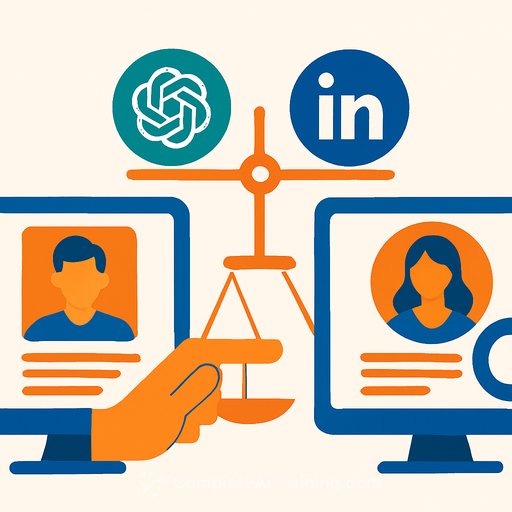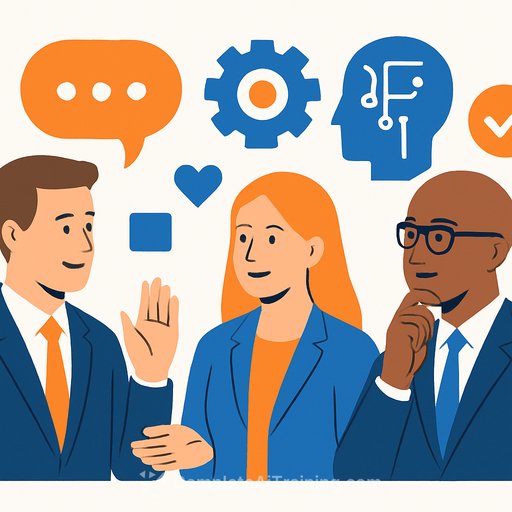OpenAI vs. LinkedIn: What HR Should Do Now
On September 4, OpenAI announced it's moving directly into job search. The pitch: match people to roles with context alone-no titles, résumés, applications, or screening. A fully automated flow from requirement to hire. Fast, cheap, and at scale.
The plan reportedly includes an "OpenAI Academy" to upskill candidates for AI-fluent roles. The implicit bet: most future jobs will require AI literacy. The open question for HR: does this dethrone LinkedIn-or simply force HR to redesign how hiring works?
Will This Replace LinkedIn? Not So Fast
LinkedIn is more than a job board. It's a public stage for professional identity, status, and lightweight social validation. That stickiness isn't easy to clone. Any contender has to match hiring efficiency and the social loop that keeps people checking in daily.
Meanwhile, HR has already automated big chunks of the funnel. We've seen AI cover letters, AI résumés, AI-curated portfolios, even AI avatars showing up for interviews. On the recruiter side, AI scanning, automated outreach, and-less positively-fake entities fishing for data or fees. The system is crowded with proxies.
The Intangibles Still Matter (and They're Messy)
Nonverbal signals-tone, facial expression, body language-can correlate with later performance. Automated interviews can miss useful "intangibles" like curiosity, initiative, and resilience that show up in live interaction.
There's a catch: human judgment is also a source of bias. First impressions can tilt outcomes by race, gender, and class. Your job isn't to pick a side. It's to architect a process that captures signal, reduces noise, and audits for fairness.
This HBR piece explains where automated interviews can miss the mark. Pair that with governance principles like the NIST AI Risk Management Framework to set guardrails.
What This Means for HR Right Now
Assume automation will expand. Your edge is the operating system you build around it. Here's a practical playbook.
1) Redesign Hiring for Skills and Evidence
- Rework job descriptions into skills, outcomes, and constraints. Cut vague fluff. Make signal obvious.
- Use structured interviews with anchored scoring. Keep the same questions for the same roles to enable fair comparisons.
- Add job simulations and work samples. Give candidates a small, relevant task. Grade with a rubric.
- Calibrate panels. Short, tight training on evaluation bias and scoring consistency.
2) Keep Humans in the Loop Where It Counts
- Automate sourcing, scheduling, and first-pass screening. Insert humans at decision gates.
- Use live interviews to test edge attributes: judgment, learning speed, collaboration under constraint.
- Set thresholds: automated match proposes, humans dispose. Make it policy, not preference.
3) Guard the Funnel Against AI Fraud
- Identity and work verification: cryptographic signing for assessments, ID checks before final rounds, and clear privacy disclosures.
- Portfolio authenticity: ask for source files or version history when relevant. Spot-check with quick live "walkthroughs."
- Policy clarity: state what AI assistance is acceptable for tests, and how you'll evaluate it.
4) Build an AI Governance Stack
- Document every AI tool in the hiring flow. Owner, purpose, data used, bias audits, and fallback procedures.
- Run adverse impact analysis by stage. Track it monthly. If you can't measure it, you can't fix it.
- Create a candidate appeal path. If automation made an error, show how to challenge it.
5) Modernize Your Metrics
- Quality of hire: performance after 6-12 months, manager satisfaction, and ramp speed-not just time-to-fill.
- Funnel quality: interview-to-offer ratio, offer acceptance, new hire retention at 90/180 days.
- Model health: false negatives/positives from automated screens, and drift over time.
6) Diversify Sourcing Beyond Any Single Platform
- Don't anchor to one network. Build direct talent communities, alumni groups, and role-specific pipelines.
- Encourage referrals with clarity: who, why, and what "good" looks like in skills and culture add.
- Treat your careers site as a product: fast, clear, and honest. Candidates feel quality in the details.
7) Upskill Your Team on AI Fluency
- Set baseline AI literacy for recruiters and hiring managers: prompts, evaluation, and tool limits.
- Train on structured interviews, work-sample design, and fairness audits. This is the new core.
- If you need a starting point, browse role-based AI learning paths here: Complete AI Training - Courses by Job.
What Happens If OpenAI's Match Works?
If automated matching nails fit, hiring becomes a utility. HR's value then shifts to culture design, manager enablement, internal mobility, and continuous learning. Less pipeline wrestling, more org-building.
If it doesn't, teams that over-index on automation will miss high-upside talent and compound bias. Either way, HR wins by owning the system-clear skills, fair process, strong governance, and human judgment where it matters.
What to Do This Quarter
- Audit your funnel: where does AI touch candidates, and who owns each decision?
- Replace generic interviews with a structured kit: questions, rubrics, and a 30-minute scoring training.
- Add one work sample for each high-volume role. Start small. Iterate.
- Stand up a basic fairness dashboard: stage conversion by demographic, plus time-to-hire and quality-of-hire.
- Publish your AI policy to candidates. Transparency builds trust.
The Bottom Line
Automation will keep advancing. Social platforms will keep shifting. Your leverage comes from design: skills-first role definitions, measurable process, trusted guardrails, and intentional human oversight.
If a new platform beats LinkedIn, you'll be ready. If it doesn't, you'll still run a cleaner, faster, fairer system-and hire better people because of it.
Your membership also unlocks:






